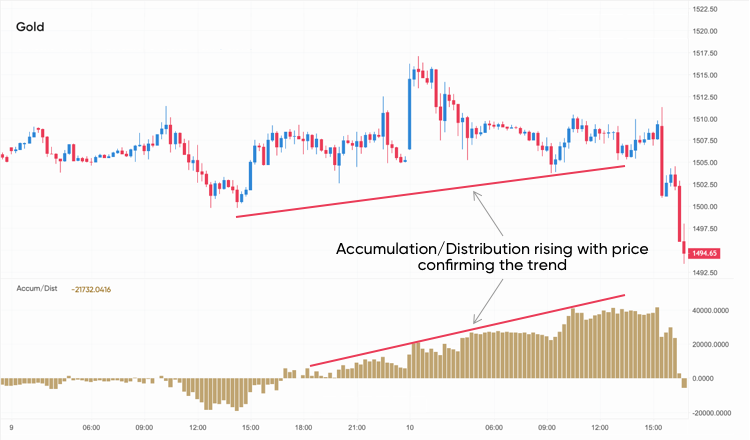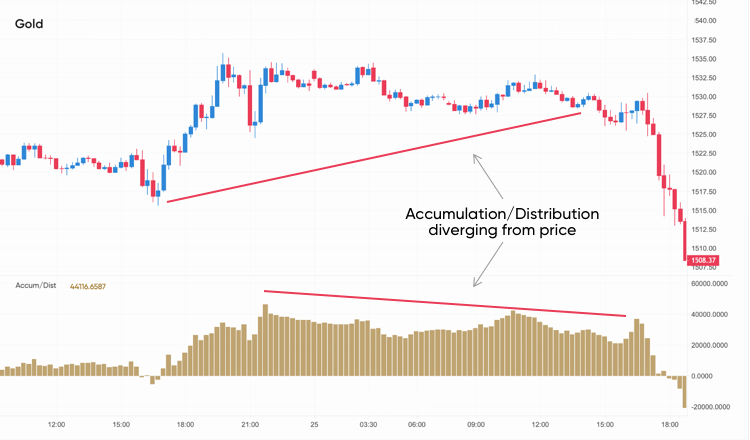Your ultimate guide to trade with accumulation/distribution line

What is accumulation/distribution line?
The accumulation/distribution indicator is a volume-based technical indicator, which is aimed to estimate the cumulative flow of money into and out of a security. In other words, it helps to measure the underlying supply and demand.
The indicator is designed to assess whether the stock is being accumulated or distributed, ie, whether traders are actually buying or selling it. The accumulation/distribution, or the ADL indicator, identifies divergences between the volume flow and stock price. It helps to get a clearer picture of how strong a trend is.
Traders can use this indicator to prove a stock’s trend or anticipate future price reversals. When the price is going up, but the ADL indicator is going down, it means that buying (accumulation) volume is not strong enough to support the price upswing, which may indicate a forthcoming decrease in the stock’s price.
Who invented accumulation/distribution line indicator?
The accumulation/distribution line was invented by a famous stock analyst Marc Chaikin. Originally, Marc Chaikin referred to the ADL indicator as the cumulative money flow line. Later on, it became closely related to Chaikin’s other indicators, including the Chaikin oscillator and Chaikin money flow indicator.
Technical analysis: how to use accumulation/distribution indicator?
Breaking down the accumulation/distribution formula, you’ll see that it is a single line tool, which belongs to the oscillator family and fluctuates around a zero (0.00) level.
Basically, there are three steps to calculate the accumulation/distribution line indicator:
- Step 1Calculate the money flow multiplier (MFM), to create an accumulation/distribution line. The line rises when the multiplier has a positive meaning and falls when the multiplier is negative. It is calculated under the following formula: [(close – low) – (high – close)] / (high – low).
- Step 2Multiply the calculated MFM by the volume over the given period and get the money flow volume (MFV). It is calculated as follows: MFV = MFM x volume for the period.
- Step 3Maintain a running total of money flow volume to form the accumulation/distribution Line (ADL): ADL = previous ADL + current period’s money flow volume.
How to read accumulation/distribution chart
The money flow multiplier also known as close location value usually fluctuates between +1 and 1. It compares the closing price for a certain period to the range over that period.
-
A MFM value equal to zero means that the price closed halfway between the high and low of the range
-
A value of +1 indicates that the close is equal to the high of the range
-
A value of 1 indicates that the close is equal to the low of the range
When the close is in the upper half of the high-low range, the multiplier is positive, which indicates that the buying pressure is strong enough. When the multiplier is positive, the ADL indicator rises.
When the close is lower than the high low range, the multiplier is negative. It indicates that the selling pressure is stronger than the buying pressure. When the multiplier is negative, the ADL indicator falls.
Why is accumulation/distribution line useful for traders?
Accumulation/distribution indicator trading signals are often applied to confirm whether a stock is trending, whether the trend is strong enough to continue, or to predict upcoming price reversals.
Accumulation/distribution trading strategy usually defines four major trade signals, which help to spot and analyse the trend:
-
Confirmation of the bullish trend
-
Confirmation of the bearish trend
-
Bullish divergence
-
Bearish divergence
Confirmation of the trend looks rather straightforward. It helps to identify the strength of a trend. When the accumulation/distribution line is rising together with the price, it confirms the uptrend. When the ADL line is falling together with the falling price it supports the downtrend.

Past performance is not a reliable indicator of future results.
However, another important feature of the ADL indicator is divergence. It happens when the ADL line contradicts the price movement, providing a bullish or bearish signal.

Past performance is not a reliable indicator of future results.
A bearish divergence happens when the asset’s price creates higher tops on the chart, while the indicator is giving lower tops. In case of a bearish divergence, the security tends to make a rapid bearish movement. The bullish divergence works the same way, but in the opposite direction.
The accumulation/distribution line, as many other popular technical analysis tools, shouldn’t be used as a standalone indicator, as it is pretty hard to mark minor changes in the volume flow. It often works better together with other effective technical indicators, including the money flow index (MFI) and the relative strength index (RSI).